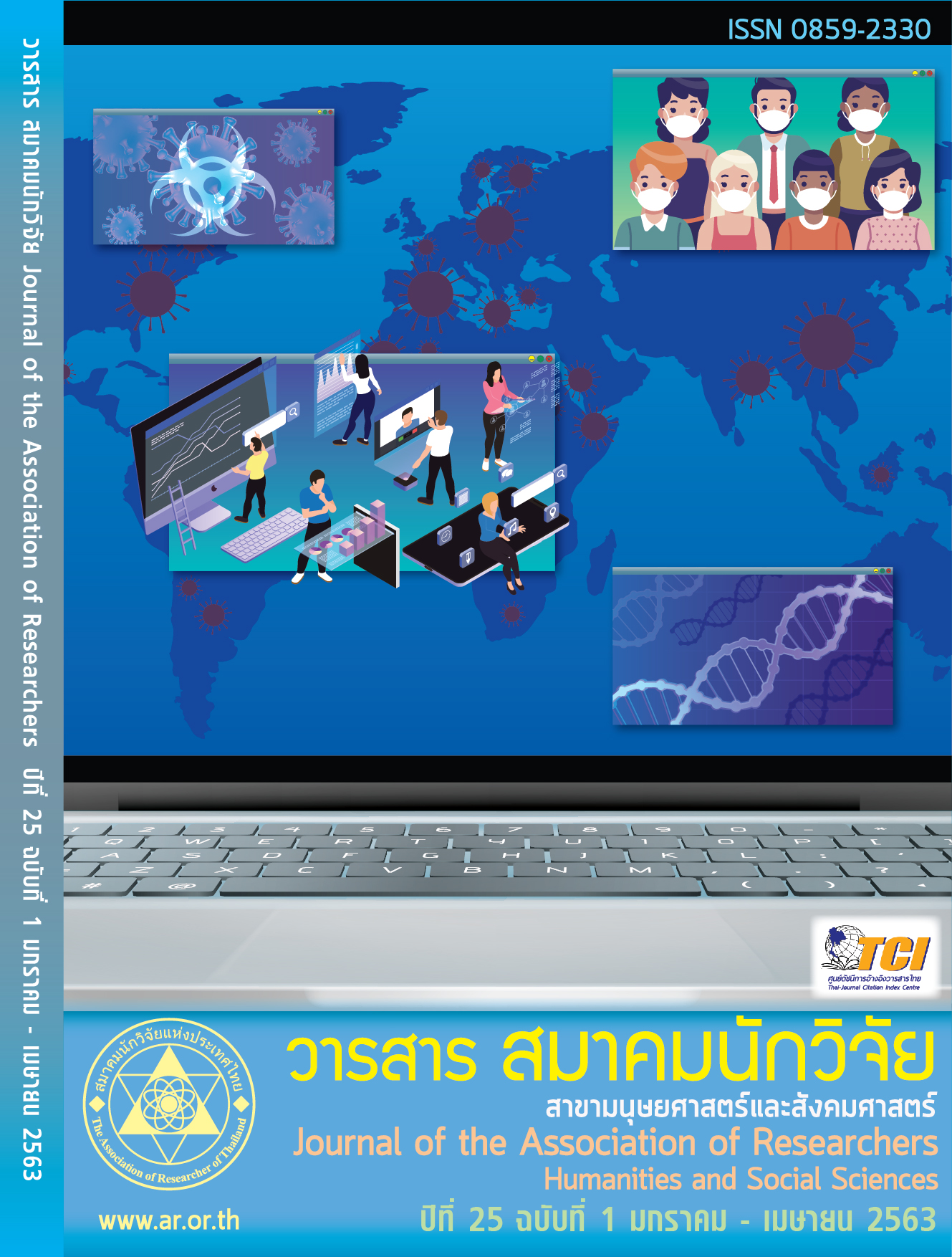The Development of Holistic Health Care Model for Secondary School Students
Main Article Content
Abstract
The purpose of this research was to 1) develop a holistic health care model for secondary school students, 2) assess the holistic health care skills of students by using a holistic health care model for secondary school students, and 3) evaluate Satisfaction with using the holistic health care model for secondary school students Use the research methodology that combines methods. In the aspect of research and development The samples were students under the holistic health care assembly. Benjamarachuthit School Nakhon Si Thammarat Under the Office of Secondary Educational Service Area 12, academic year 2017, a total of 32 people were obtained by specific selection method. The research instruments were the holistic health care manual for secondary school students. Holistic health care skill assessment And the student satisfaction assessment form Data analysis includes content analysis. Determination of the consistency index And use the finished program Average analysis Standard Deviation Test statistics
The research found that
- The holistic health care model for secondary school students has 4 components which are physical, mental, social, intellectual And the holistic health care steps of the students, there are 6 steps which are 1. Pre-assessment stage 2. Prepare step 3. Acting step 4. Step of improvement and application
- Step Establishing personality traits. 6. Assessment stage after school
- The result of the holistic health care skill assessment of students after school was higher than before in all 4 areas with statistical significance at the level of .05, which is from the table t. The main point is 2.04, the physical t is equal to 22.37 aspects. The mind is 20.36, the society is 19.94, and the intelligence is 19.92 which is higher than the main point.
- Satisfaction with using the holistic health care model for secondary school students found that Students are satisfied with the holistic health care model for secondary school students. The overall picture is in the high level (x̅= 4.34)
Article Details
บทความที่ปรากฏในวารสารนี้ เป็นความรับผิดชอบของผู้เขียน ซึ่งสมาคมนักวิจัยไม่จำเป็นต้องเห็นด้วยเสมอไป การนำเสนอผลงานวิจัยและบทความในวารสารนี้ไปเผยแพร่สามารถกระทำได้ โดยระบุแหล่งอ้างอิงจาก "วารสารสมาคมนักวิจัย"
References
องค์รวม. คณะศิลปะศาสตร์ สาขาวิชาการจัดการสุขภาพชุมชน สถาบันการเรียนรู้เพื่อปวงชน.
จุมพล รามล. (2560). พฤติกรรมการดูแลสุขภาพตนเองแบบองค์รวมของนักศึกษาชั้นปีที่หนึ่ง
มหาวิทยาลัยธรรมศาสตร์ ศูนย์รังสิต. วิทยานิพนธ์หลักสูตรศึกษาศาสตรมหาบัณฑิต. สาขาวิชา
วิทยาการชะลอวัยและฟื้นฟูสุขภาพ วิทยาลัยการแพทย์บูรณาการ มหาวิทยาลัยธุรกิจบัณฑิตย์
นราภรณ์ ขันธะบุตร (2552). การพัฒนารูปแบบการสร้างเสริมสุขภาพองค์รวมสำหรับนักเรียนชาย
ระดับมัธยมศึกษาตอนต้นที่มีภาวะอ้วน. วิทยานิพนธ์หลักสูตรปริญญาครุศาสตรดุษฎีบัณฑิต.
สาขาวิชาพลศึกษา ภาควิชาหลักสูตร การสอนและเทคโนโลยีการศึกษา คณะศึกษาศาสตร์
จุฬาลงกรณ์มหาวิทยาลัย.
สุรดา จันดีกระยอม และชนกพร จิตประสาร. (2557). การดูแลและการจัดการสุขภาพ. มหาสารคาม:
สำนักนักศึกษาทั่วไป มหาวิทยาลัยมหาสารคาม.
สุวิมลรัตน์ รอบรู้เจน. (2560). การพัฒนารูปแบบการดูแลสุขภาพผู้สูงอายุ สำหรับผู้ดูแลผู้สูงอายุ อำเภอ
วารินชำราบ จังหวัดอุบลราชธานี. วารสารมหาวิทยาลัยนราธิวาสราชนครินทร์ ปีที่ 9 ฉบับที่ 3 หน้า 57- 69
สำนักงานกองทุนสนับสนุนการสร้างเสริมสุขภาพ. (27 ธันวาคม 2555). เด็กไทยรอบปี 55 น่าห่วงขาด
ทักษะชีวิต ติดเหล้าบุหรี่ไม่ลดลง. Web site.http://www.thaihealth.or.th/Content/14516
-----------. (14 มกราคม 2556). เปิดผลสำรวจทักษะของเด็กไทยในศตวรรษที่ 21.
Web site. http://www.qlf.or.th/Home/Contents/570.
Bloom, B. S. (1956). Taxonomy of educational objectives. (Handbook II: The affective domain). New York: David Mckay
Glaser. (1965). Barney G. Glaser. Issue 12, Issue 4 (Spring, 1965) Published by: Oxford
University Press on behalf of the Society for the Study of Social Problems.
Harrow, A.J. (1972). A taxonomy of the psychomotor domain: A Guide for Developing
Behavioral Objectives New York: David McKay.
Landrum et.al, (1993). Mental Health Psychiatric Nursing A Holistic Life-Cycle Approach.
Simpson. D. Teaching physical education: A system approach. Boston: Houghton Mufflin Co.
Tyler, Ralph W. (1950). Basic principles of curriculum and instruction. Chicago: University of Chicago.
Web site. http://healthylife4000111.blogspot.com/2013/01 /1_27.html
World Health Organization. (1996). Promoting health through school. Geneva: World Health
Translated Thai Reference
Kannika Panyawong and Phanat Pruksunan. (2012). Documentation for learning about health
careHolistic. Faculty of Arts Community Health Management Program Learning Institute for All. (In Thai).
Chumphon Ram. (2017). Holistic self-care behavior of first year students. Thammasat
University, Rangsit Center. Master of Education Program Thesis. Branch Anti-aging and health rehabilitation
technology College of Integrative Medicine Dhurakij Pundit University. (In Thai).
Naraporn Khantabudr. (2009). The development of a holistic health promotion model for male students Upper secondary level with obesity.
Dissertation, Doctor of Education Degree Program. Physical Education Program Department Teaching and Educational
Technology Faculty of Education Chulalongkorn University. (In Thai).
Surada Chanddi Kraomom and Chanokpornjitprasarn. (2014). Health care and management.
Maha Sarakham: Bureau General student Mahasarakrm university. (In Thai).
Suwimonrat Robunjen. (2017). The development of elderly health care model. For the elderly caregivers of the district Warin Chamrap,
Ubon Ratchathani Province. Journal of Narathiwat Rajanagarindra University, Year 9, Issue 3 Pages 57- 69. (In Thai).
Department of Health. (27 December 2012). Thai children around the year 55 is worrisome.
Life skills, alcohol dependence, cigarettes do not decrease. Web site. pttp://www.thaihealth. or.th /Content/14516. (In Thai).
----------(14 January 2013). Opening the survey of Thai children's skills in the 21st century.
Web site. http://www.qlf.or.th/Home/Contents/570. (In Thai).


